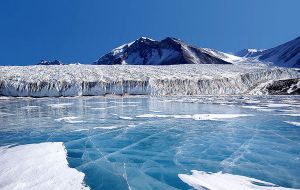MercoPress. South Atlantic News Agency
Scientists Discover Deep-Ocean Current Moving Northward from Antarctica
 The current flows at depths well below 3,000 meters, with hit speeds greater than 700 meters per hour and carrying volumes as high as 30 million cubic meters per second
The current flows at depths well below 3,000 meters, with hit speeds greater than 700 meters per hour and carrying volumes as high as 30 million cubic meters per second Work in Japan and Australia has revealed that a deep-ocean current is carrying frigid water rapidly northward from Antarctica along the edge of a giant underwater plateau.
Other research teams had previously identified a deep current along the eastern edge of the Kerguelen Plateau, a more than 2,200-kilometre-long rise some 3,000 kilometers south-west of Australia. But estimates of its speed, taken as “snapshots” by instruments deployed from research vessels, had been “all over the place”, says Steve Rintoul, a physical oceanographer at the Antarctic Climate and Ecosystem Cooperative Research Centre in Hobart, Australia, and a co-author of the new study.
Yasushi Fukamachi, an ocean scientist at Hokkaido University in Sapporo, Japan, led a team effort to determine the exact nature of the current. The researchers moored over 30 current and temperature recorders across its probable path and left these in place for two years. When they retrieved their instruments, the scientists discovered that the current, which flows at depths well below 3,000 meters, sometimes hit speeds greater than 700 meters per hour, carrying volumes as high as 30 million cubic meters per second.
No other deep current in the Southern Hemisphere is known to move that quickly.The current is formed by cold water sinking in the Ross Sea and off the coast of Adelie Land, on the Australian-facing side of Antarctica. Once in the abyss, the water flows eastward along the coast of Antarctica before hitting the Kerguelen Plateau. Then, just as the Gulf Stream hugs the eastern edge of North America, Coriolis force from Earth's rotation causes the Antarctic water to embrace the plateau's eastern flank. The result is a narrow, and so fast-moving, stream, about 50 kilometers wide.
This is significant because it represents a “fast lane” by which climatic and environmental changes affecting the Southern Ocean can propagate northward, says Alejandro Orsi, a physical oceanographer at Texas A & M University in College Station, who was not involved in the study. Proof that this is already occurring, he adds, can be seen from the fact that the deep waters near the Kerguelen Plateau already show “clear signs” of reduced salinity relating to changes in the rate of melting of Antarctic ice sheets.
Understanding such currents could help scientists to predict how the world will react to increasing levels of carbon dioxide, says Richard Alley, a geoscientist at Pennsylvania State University in University Park. To begin with, he says, if heat goes into warming the deep ocean rather than surface waters, it will have less effect on sea-level rise because cold water in the ocean's depths expands less than warm surface waters. Similarly, heat and carbon dioxide contained in deep-ocean currents are sequestered from the atmosphere until the water rises back the surface, many years later.
Similar flows in the North Atlantic account for the fact that Europe is warmer than comparable latitudes in Japan, Fukamachi says. But the currents could change. “We're not saying this could happen instantaneously, like the movie The Day After Tomorrow,” Fukamachi says, “but understanding this kind of current is very important to understanding global climate.”
Nature may recently have provided an opportunity to test our understanding of how changes in these processes work. In mid-February, a giant block of ice 78 kilometers long broke off the tongue of ice spilling into the sea from the Australian Antarctic Territory's Mertz Glacier. Previously, that tongue had blocked icebergs from collecting on its western side, creating an open area where winds blowing off the Antarctic interior could rapidly produce extremely cold water that would sink to the depths and feed the deep currents.
News reports hyped the event as a disaster that could radically affect global ocean circulation, but nobody knows what the effect will be, Rintoul says. ”It's like a natural experiment. I think it will teach us a lot about the processes responsible for forming this dense water”.




Top Comments
Disclaimer & comment rulesCommenting for this story is now closed.
If you have a Facebook account, become a fan and comment on our Facebook Page!